I’d always been curious about Red Hook, the hardscrabble, Civil War-era, industrial Brooklyn neighborhood, near my former apartment off Court Street in picturesque Carroll Gardens. But back when I was living nearby, the fits and starts of new neighborhood residents blending with old ones hadn’t quite taken hold yet. There was a short-lived decent music venue, Red Hook Blue, that made a go of it for a little while and where we rang in the year 2000, all crazed and lively inside contradicting the lonely, barren streets outside its doors—they’d actually hired a short bus to shuttle revelers to and from because, without a car, Red Hook was like a No Man’s Land, hard to get to and hard to leave. And there was always Sunny’s (aka, the Red Hook Yacht Club) for bands and a beer. But Red Hook back then wasn’t really where you went to seek out a terrific meal, artfully made cocktail, or a great bottle of wine.
The Start of Something Good
Right around the time we moved out of Kings County, a cute little eatery called Hope & Anchor opened. The name, all nautical romanticism and nod to the neighborhood’s shipping and working waterfront history, was appealing, as was its better-than-a-coffee-shop menu, with ample, alluring burger choices (lamb patty, friend?), comfort food staples, and quiet, neighborly feel. It wasn’t perfect by a long shot, but it made me wonder if maybe we should have rolled the dice on moving to this underdog of a spot. Now, after 50 years of physical separation from its adjoining, more prosperous neighborhoods—thanks, in part, to the building of the Gowanus Expressway in 1946 and the Brooklyn-Battery Tunnel in 1950, which literally set Red Hook on the other side of the proverbial tracks—something has started to change. And that something is kind of delicious.
The culinary and cocktail side of Red Hook is a slow simmer, but one that’s more than worth the trek and time. It’s not exactly the same sort of Renaissance that’s exploded along Court and Smith Streets in neighboring Carroll Gardens and Cobble Hill, but for my sensibilities, what’s happening in Red Hook is arguably a little better; a little more interesting; a little more particular.
It’s here that the borough’s very first wine-making outfit opened, Red Hook Winery, housed in an old cannonball factory on Dwight and Van Dyke Streets—the brainchild of boutique winemakers Abe Schoener and Robert Foley, Angels Share importer Mark Snyder, and Amagansett Wines & Spirits owner Michael Cinque.
The culinary and cocktail side of Red Hook is a slow simmer, but one that’s more than worth the trek and time.
Across the street sits the digs for the much-lauded Six Point Brewery, a craft beer brewer that’s on some of the city’s most lauded menus, including the outstanding Red Hook eatery Good Fork, which opened its etched-glass front door in 2006 to much acclaim for its locally minded dinner fare. And then there’s the recent opening of Portland’s Stumptown Coffee Roasters on Van Brunt Street, who sell their sought-after beans by the bag or brewed in a cup.
Eating Our Way Through
One recent afternoon, I brought my friend Maria for an eating and drinking jaunt down Van Brunt Street, the sort of epicenter of the Hook’s burgeoning scene. Born and raised in Brooklyn, Maria is no stranger to the morphing of a neighborhood, and was curious to check it out. We drove over (there are no subways that stop in the neighborhood, although you can easily hop a B61 bus, or grab a water taxi from Pier 11 in Manhattan–free on weekends; $5 during the week–which departs every 20 minutes and deposits you at IKEA at the water end of Van Brunt), and parked near Pioneer Street, close to our first stop of the day, Red Hook Lobster Pound.
If you’re looking to be dazzled, Van Brunt Street can be a little disappointing. And maybe I’d been talking up Red Hook a bit too much, too, as Maria’s furrowed brow told me what she was thinking, (“This is Red Hook?”). But like the spirit of the street we parked near, discovery is all about withholding judgment, and I was feeling confident that by Coffey Street and with a full belly, Maria’s brow would do cartwheels. And it did.
In Red Hook Lobster Pound, we decided to split a lobster roll ($13), as well as some Maine root beer soda ($2.50) and a house-made Whoopie Pie ($3) the size of a small animal. “Let the Whoopie pie sit for about a half hour,” cautioned its maker, co-owner Susan Povich, so we tucked it into a bag to save for later, since we had a whole bunch of eating left to do anyway.
We got our order, walked outside the take-out station and next door through the wooden swing doors to the sit-down area, with its ceiling full of dangling buoys and broad wooden picnic tables. I carefully cut the crustacean-filled sandwich in half–its massive chunks of chilly, juicy, sweet meat barely contained in its traditional toasted, buttered hot dog bun. It was scarfed in a few minutes flat. Despite wanting another, we forged on, because steps away sat a curiosity I had yet to try out: The Brooklyn Ice House.
Calories? Who’s Counting?
According to a Houston ex-pat friend of mine, ice houses were a Texas staple where you could go and get a cold beer and maybe a little somethin’ to eat any given time of day, which is pretty much what’s been transplanted to this spot on 318 Van Brunt Street. We stood outside looking in at the worn-out red leather booth seats and rough-hewn wooden tables, but it was the sign outside for pulled pork that drew us in to sit. As it turned out, the day bartender was a Texan transplant, too, and thus had an easy time explaining to me a mystery menu item that I couldn’t seem to resist–Frito pie. “It’s basically like Fritos mixed with ground beef and melted cheese, and we sprinkle some jalapenos on top, too. It’s good!” Maria was game, and with a simultaneous adoration of anything that reminds me of childhood foods (hello, Sloppy Joe’s!) coupled with the notion that I’ll pretty much try anything at least once, we ordered.
The pulled pork were two sammies for five bucks, Frito pie was three, and while we waited I ogled the impressive 50+ beer list that spans the globe. A Corona six-pack holder contained condiments, like a sweet-and-spicy barbecue sauce that perked up the tender, juicy pulled pork, which went down nicely with a cold Hofbrau on tap. Maria pulled out cards from one of the the pile of board games the Ice House keeps on hand for its customers, and asked me random Trivial Pursuit movie questions while I spooned into the cheese-topped pie–all crunchy and spicy, and a guilty pleasure next to the pork (and something I could well imagine having been a staple in my life if I were still in the habit of taking up late-night stool space in dive bars).
We settled up and, with a craving for coffee, wandered a few blocks down to the pretty, airy cafe Baked.
So the legend goes, owners Matt Lewis and Renato Poliafito were droning on in cubicles in the world of New York advertising, but day in and day out, they were left empty of the sweet stuff in life, and so Baked was born in 2005. They serve Stumptown Coffee and the excellent teas sourced by Serendipitea, and in addition to making their own granola, marshmallows, and having written a pretty cool cookbook to boot, it’s the baked goods that drag you in by the tongue.
Like the it’s-so-good-I-almost-fainted coffee crisp, an ample square of dark-chocolate cake base topped with deliriously addictive coffee buttercream, and a final thin layer of espresso-tinged chocolate glaze. Sweet candy Jesus, it’s good. As are the many other treats and layered luscious goodies that will have you all a-jitter with the best sugar high ever.
Caffeinated to the hilt, I felt a depressant would be needed in my near future, so our next stop was Botta di Vino, a fantastic Italian-minded wine boutique, whose owner Triciann Botta, logged years in the restaurant world under the tutelage of Jonathan Waxman at Barbuta, where she grew to adore the vino of the boot-shaped country.
One of the things Botta loves most is gently nudging her customers to discover something new and wonderful, like the bottle of Lacrima di Morro d’Alba that she turned me onto, with its irresistible nose of lavender, cherry, and red plums. Botta, whose store opening was chronicled in the Discovery show Construction Intervention, also offers monthly 2-day, 2-hour wine classes for the price of a bottle of something in the store (which can easily go for under $10), in which curious imbibers get to taste and discover wine from all corners of the world.
Spice of Life
As we left, bottle in tow, Maria remarked that she really was loving the entrepreneurial, neighborhood spirit that spots like Botta di Vino and the other stops we made all seemed to generously have in spades. She was starting to see what I love about the food and drink scene here: the business owners might not always be natives of the nabe, or even the city for that matter, but they have a strong desire to be part of a community. To feed each other, and the area, in a way that lends cohesiveness at a time when the courting of celebrity chefdom and big box stores (and eateries, for that matter), threatens to pave over the very thing that makes New York… New York: Its neighborhoods — potholes, watering holes, dreamers, characters, Frito-pie slingers, and all.
Our final stop of the day was my favorite, the best one that I saved for last. Writer and mixologist St. John Frizell named his corner spot Fort Defiance after the area’s Revolutionary War military outpost. Today, Fort D, with its dark wood wainscoting, robin’s-egg-blue walls, and smallish square tables covered in colorful plastic retro prints, has easily become a beloved, quirky neighborhood staple since it opened about a year and a half ago.
Here, Frizell presides behind the bar, making some of the most balanced and lovely cocktails in all of Gotham (riffs on historical recipes for which he makes all his own mixers, tonic water, ginger ale, et al), a craft he honed working for Audrey Saunders at Manhattan’s Pegu Club. The small but gingerly southern-tinged, excellent food menu under the artful hand of chef Bobby Duncan can make you slip easily from, oh, I’ll just have a little nibble, to indulging in full-on entrees, like the salty, juicy, perfectly roasted chicken with pan gravy and excellent mashed potatoes, to recent wintry additions like the fragrant Guinness and local lamb stew.
Maria and I bellied up to the bar, where I sipped on a Marconi Wireless–a recipe Frizell resurrected from the Old Waldorf-Astoria bar book consisting of Laird’s apple brandy, sweet vermouth, and bitters, and which reminds me of a more elegant version of a Manhattan–and we went the decadent snack route,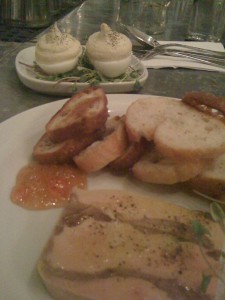
sharing what are hands-down the best deviled eggs I’ve ever had the pleasure of eating–their yokey center whipped into velvety submission with Greek yogurt, mayonnaise, Dijon mustard, mustard seeds, and a bit of Old Bay and cayenne pepper to make sure you’re paying attention—and a slice of silky foie gras with wedges of toasted French bread.
With only crumbs left on the plate and presumably no room in our stomachs for more, we gave up our stools at the zinc-top bar, and walking out into the now-dark early evening, while others filed in to the Fort’s cozy climes.
Eating Whoopie
“It’s pretty great here, a really cool neighborhood,” Maria said as we headed toward the car, full and happy. But in addition to opinion conversion, there was one souvenir from the day that we’d nearly forgotten. She reached into her bag and, with a big grin, pulled out the treat we’d saved for last–a just-right soft Whoopie pie. She split it and handed me half, the cake-like chocolate cookies pressing into the marshmallow sweet fluffy filling and we ate, giggling in the way only a whoopie pie can encourage, crumbs tumbling to the ground as we leaned against the car.
Its not exactly the image that used to come to mind when I’d think about salty, “On the Waterfront” Red Hook years ago. Except, of course, maybe it is.
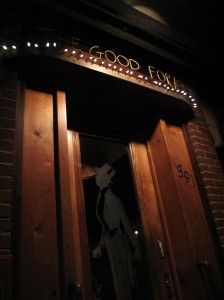
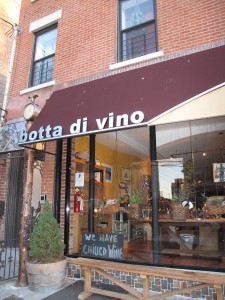
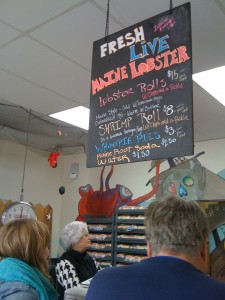
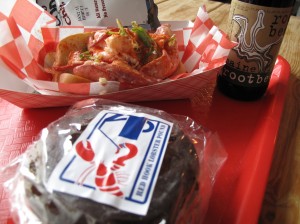
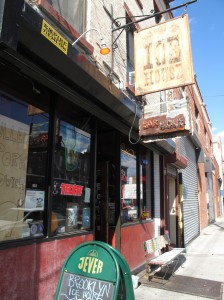
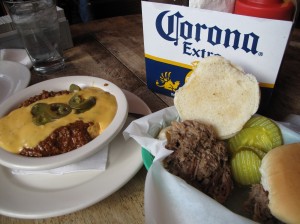
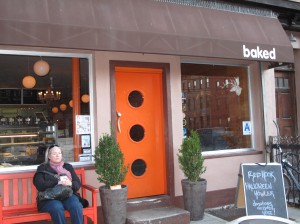
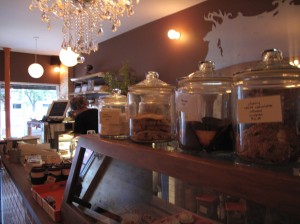
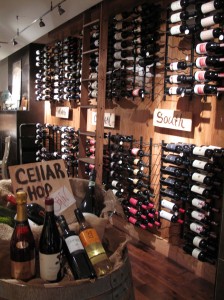
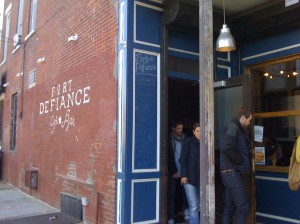
RT @ToqueMag: #RedHook: Brooklyn's Spirited and Edible Waterfront http://bit.ly/b2mVhS